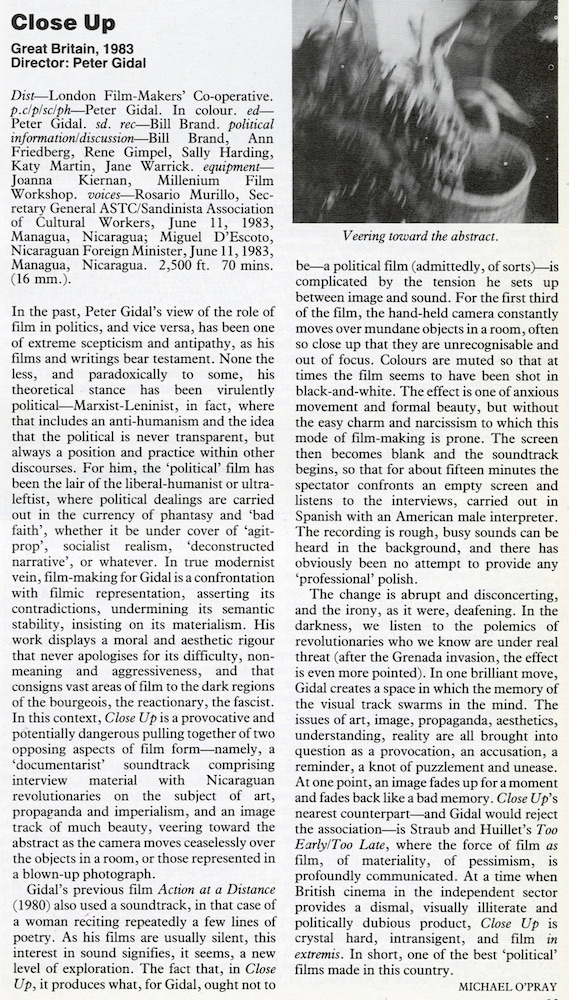Michael O’Pray on “Close Up”
There’s a rare opportunity to see Peter Gidal’s “feature length” film Close Up on Friday 20 May 2016, aptly screening at London’s Close-Up Film Centre. Michael O’Pray’s perceptive review of the film, originally published in Monthly Film Bulletin in January 1984, appears below as image and text.
Michael O’Pray on “Close Up” (1984)
In the past, Peter Gidal’s view of the role of film in politics, and vice versa, has been one of extreme scepticism and antipathy, as his films and writings bear testament. None the less, and paradoxically to some, his theoretical stance has been virulently political – Marxist-Leninist, in fact, where that includes an anti-humanism and the idea that the political is never transparent, but always a position and practice within other discourses. For him, the ‘political’ film has been the lair of the liberal-humanist or ultra-leftist, where political dealings are carried out in the currency of phantasy and ‘bad faith’, whether it be under cover of ‘agit-prop’, socialist realism, ‘deconstructed narrative’, or whatever. In true modernist vein, film-making for Gidal is a confrontation with filmic representation, asserting its contradictions, undermining its semantic stability, insisting on its materialism. His work displays a moral and aesthetic rigour that never apologises for its difficulty, non-meaning and aggressiveness, and that consigns vast areas of film to the dark regions of the bourgeois, the reactionary, the fascist. In this context, Close Up is a provocative and potentially dangerous pulling together of two opposing aspects of film form – namely, a ‘documentarist’ soundtrack comprising interview material with Nicaraguan revolutionaries on the subject of art, propaganda and imperialism, and an image track of much beauty, veering toward the abstract as the camera moves ceaselessly over the objects in a room, or those represented in a blown-up photograph.
Gidal’s previous film Action at a Distance (1980) also used a soundtrack, in that case of a woman reciting repeatedly a few lines of poetry. As his films are usually silent, this interest in sound signifies, it seems, a new level of exploration. The fact that, in Close Up, it produces what, for Gidal, ought not to be – a political film (admittedly, of sorts) – is complicated by the tension he sets up between image and sound. For the first third of the film, the hand-held camera constantly moves over mundane objects in a room, often so close up that they are unrecognisable and out of focus. Colours are muted so that at times the film seems to have been shot in black-and-white. The effect is one of anxious movement and formal beauty, but without the easy charm and narcissism to which this mode of film-making is prone. The screen then becomes blank and the soundtrack begins, so that for about fifteen minutes the spectator confronts an empty screen and listens to the interviews, carried out in Spanish with an American male interpreter. The recording is rough, busy sounds can be heard in the background, and there has obviously been no attempt to provide any ‘professional’ polish.
The change is abrupt and disconcerting, and the irony, as it were, deafening. In the darkness, we listen to the polemics of revolutionaries who we know are under real threat (after the Grenada invasion, the effect is even more pointed). In one brilliant move, Gidal creates a space in which the memory of the visual track swarms in the mind. The issues of art, image, propaganda, aesthetics, understanding, reality are all brought into question as a provocation, an accusation, a reminder, a knot of puzzlement and unease. At one point, an image fades up for a moment and fades back like a bad memory. Close Up’s nearest counterpart – and Gidal would reject the association – is Straub and Huillet’s Too Early/Too Late, where the force of film as film, of materiality, of pessimism, is profoundly communicated. At a time when British cinema in the independent sector provides a dismal, visually illiterate and politically dubious product, Close Up is crystal hard, intransigent, and film in extremis. In short, one of the best ‘political’ films made in this country.
Michael O’Pray
Monthly Film Bulletin, January 1984

